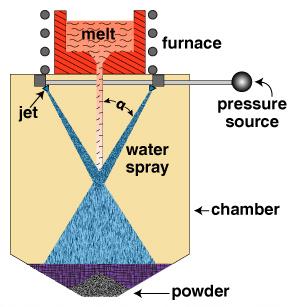- FMA
- The Fabricator
- FABTECH
- Canadian Metalworking
Our Publications
Categories
- Additive Manufacturing
- Aluminum Welding
- Arc Welding
- Assembly and Joining
- Automation and Robotics
- Bending and Forming
- Consumables
- Cutting and Weld Prep
- Electric Vehicles
- En Español
- Finishing
- Hydroforming
- Laser Cutting
- Laser Welding
- Machining
- Manufacturing Software
- Materials Handling
- Metals/Materials
- Oxyfuel Cutting
- Plasma Cutting
- Power Tools
- Punching and Other Holemaking
- Roll Forming
- Safety
- Sawing
- Shearing
- Shop Management
- Testing and Measuring
- Tube and Pipe Fabrication
- Tube and Pipe Production
- Waterjet Cutting
Industry Directory
Webcasts
Podcasts
FAB 40
Advertise
Subscribe
Account Login
Search
Old technology is used to produce metal powders for the latest 3D printers
Applying a pressurized liquid or gas to metal breaks the material into particles fine enough for additive manufacturing systems
- By Kip Hanson
- July 19, 2019
I never gave much thought to the manner in which steel billet and rod is manufactured. Sure, I’ve marveled over the years at the sparks-flying, molten-metal, glowing-red videos of steel mills in action. And I vaguely remember attending a semester of Metallurgy 101 somewhere along the line.
But all I really cared about during my machining days was how quickly and accurately I could remove material from whatever Inconel, 316 stainless steel, or Ti-6Al-4V part I happened to be working on.
With all the stories I’ve written on 3D printing over the past few years, though, I’ve come to wonder about the flour-fine powdered metal used in EOS, Concept Laser, 3D Systems, Renishaw, SLM Systems, and, most recently, Velo3D machines. How the heck do they make the stuff?
At first, I assumed metal was ground up in a humungous ball mill like those used in the production of tungsten carbide. I was wrong … well, mostly. Though some metal powders (copper and iron, for example) can be produced via reduction or electrolysis and then be ground up into tiny bits, I’ve learned that the ones used in powder bed 3D printing are made via atomization.
The atomization process, put simply, involves breaking up something larger into something smaller. Like turning drops into droplets.
Three types of atomization exist—centrifugal, gas, and liquid—and none appears to be particularly new. According to the Metal Powder Industries Federation, powder metallurgy has been around for more than 100 years.
Without getting into the metallurgical weeds, pressurized-gas and liquid atomization work by squirting gas or liquid through a stream of molten metal--the melt. If you’d like to mimic the process at home, melt a few weekend’s worth of beer cans and pour them through a funnel, hitting the aluminum exiting the funnel tip with air from a compressed air gun (gas atomization) or water from a garden hose whose tip you’ve partially blocked with your thumb (liquid atomization).
With both techniques, the result will be a relatively fine mist of Pabst Blue Ribbon-tainted metal all over your driveway.
The other method—centrifugal atomization—can be replicated by pouring the molten beer cans onto your kid’s Spin Art machine. The little bits that fly off the rotating disk and hit the walls represent metal powder, albeit an exceedingly crude version thereof.
That’s it for today’s lesson on metal powder production. Hopefully it provided all you practitioners of SLS, DMLS, SLM, and EBM technology with a greater measure of respect for the metals you work with each day.
But if you’re like me, you might not care. Just bring me the metal. I want to make parts.
About the Author

Kip Hanson
About the Publication
- Podcasting
- Podcast:
- The Fabricator Podcast
- Published:
- 04/16/2024
- Running Time:
- 63:29
In this episode of The Fabricator Podcast, Caleb Chamberlain, co-founder and CEO of OSH Cut, discusses his company’s...
- Trending Articles
- Industry Events
16th Annual Safety Conference
- April 30 - May 1, 2024
- Elgin,
Pipe and Tube Conference
- May 21 - 22, 2024
- Omaha, NE
World-Class Roll Forming Workshop
- June 5 - 6, 2024
- Louisville, KY
Advanced Laser Application Workshop
- June 25 - 27, 2024
- Novi, MI




























